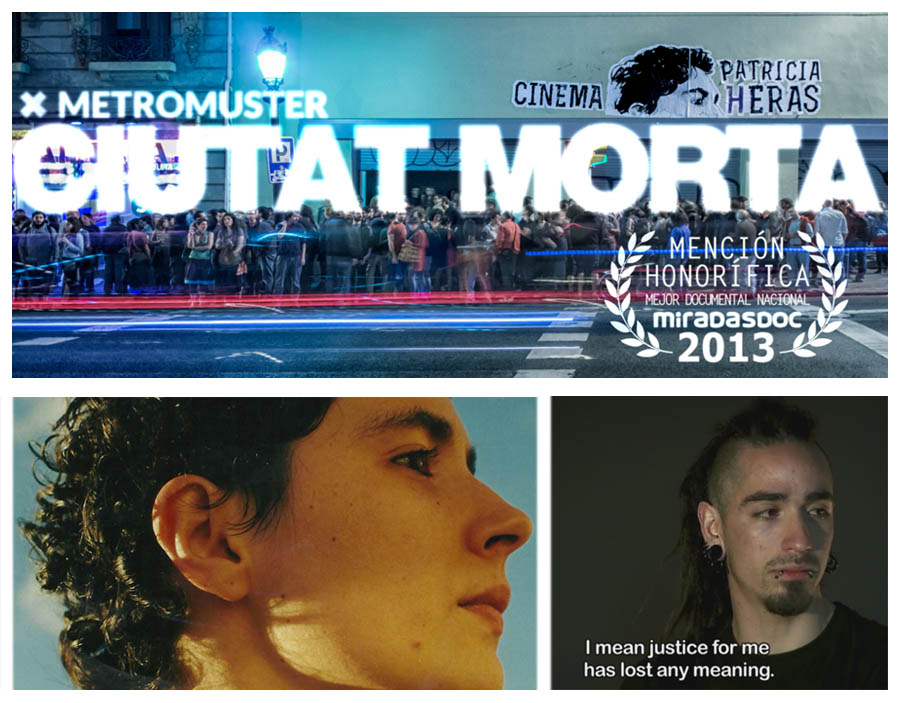
social movements


Gentri-Fric-Acció, debates in Barcelona

Criminalization of the housing movement in Brazil
Last June 24th four activists for housing were arrested in São Paulo, Brasil, while seventeen others linked to the movement for squatting were put under arrest; fifteen more are threatened of detention. The arbitrariousness of the operation is another signal of the steady drift towards fascism of the state of Brazil, that is, the complete subjugation of public institutions to the interest of big landowners and investors.
The activists were members of housing movements that squatted and returned to the common huge buildings in central São Paulo; they were accused of criminal association and extortion, something that was also employed in other countries to criminalize squatting, but not yet in Brazil. For their defense, a new organization was created: the “Popular committee in defense of political prisoners and popular movements“, whose members are activists, worker union members, artists, journalists, lawyers and other people concerned by the criminalization of social struggles.
Given the previous cases of extreme repression perpetrated by Brazilian authorities against social movements, that include extrajudiciary killings such as Marielle Franco‘s death in March 2018, it is extremely important that all people concerned to the right to housing and to the city in all the world mobilize to denounce these arrests, to claim liberty for the prisoners, and the end of arbitrary persecutions against activists.
- Sign the petition for the liberation of the four activists arrested in Sao Paulo here
- Jornalistas Livres, “Prisão de lideranças do movimento da moradia é conluvio entre promotores e policiais“, June 28th
- Interview to one of the arrested activists, Preta Ferreira: video
- Letter of the “Comité en defensa de los presos políticos de los movimientos populares” (PDF)

The second earthquake

Same old story in Milan: The destruction of Isola

City Life Vida Urbana: How evicted turn into activists

Horizontal anthropology in the margins of Barcelona

A dead city
 Like chinese boxes, this documentary not only brilliantly shows the institucional and political corruption behind the police-orchestrated hoax known as ‘4F’, which began on February 4th, 2006 in Barcelona’s calle Sant Pere Més Baix, but it also extends in a coil the understanding of horror to wider levels of society: from the police, to the judges, to the press, to social services, to the city council, to gentrification, in brief, to power in itself. Like before Joaquim Jordà’s De Nens (2003), now Ciutat Morta leads us from a particular history to the deep and terrifying comprehension of the general, of society, of the city. To the memory of Patricia Heras, the dead poet.
Like chinese boxes, this documentary not only brilliantly shows the institucional and political corruption behind the police-orchestrated hoax known as ‘4F’, which began on February 4th, 2006 in Barcelona’s calle Sant Pere Més Baix, but it also extends in a coil the understanding of horror to wider levels of society: from the police, to the judges, to the press, to social services, to the city council, to gentrification, in brief, to power in itself. Like before Joaquim Jordà’s De Nens (2003), now Ciutat Morta leads us from a particular history to the deep and terrifying comprehension of the general, of society, of the city. To the memory of Patricia Heras, the dead poet.
- “4F with names and surnames: a reflection on police, the judiciary, the press and the politicians, during the suffocating silence prior to the broadcasting of ‘Ciutat Morta’“, Jesus Rodríguez in La Directa, 21/1/2015
- “Something stinks in Barcelona“, Argelaga review, 27/1/2015
- Two petitions to sign: for the reopening of the case, and for the resignation of the Judge that seems to have written the verdict before holding the trial.
- Webpage of the movie. It is the same producer of No-res: vida y muerte de un espacio en tres actas, on the demolition of Barcelona’s Colònia Castells neighborhood.
- The mayor of Barcelona presents an award for the directors, but they do not take it: ¿how can they accept it from the same hands that have caused all this story?

The Rumba of Barcelona (the “Can Vies effect”)

There is life in the lagoon

Where there be dragons: Multiple modernities in Kathmandu

Ciudad Meridiana… exists!
The history of the neighbourhood of Ciudad Meridiana is a perfect summary of Barcelona’s urbanistic schizofrenia. Built in the Sixties on a land accounted as too damp to build a cemetery, with no transportation or services, secluded and unfit to live in, but with a strong neighbours’ movement, it has always been a problematic territory, unknown to the rest of the population: many of its inhabitants started to leave it already in the Eighties, trying to climb socially and spacially, getting over the decade in which the neighbourhood population reached its peak. Since 2001, when Catalonia and Spain were still inside the “housing market bubble”, the immigrants began arriving to Ciudad Meridiana, through mortgages the banks offered crossing the endorsements, and through other tricks that the financial capital used to “infiltrate the world of the urban poor”, as anthropologist Jaime PALOMERA writes in his essay about the neighbourhood. After the crisis began, Ciudad Meridiana was described as an eviction city, and now again for its strong neighbours and squatters movement. Recently there was an interesting debate: the City Council proposed to establish there an innovative “FabLab” related with MIT, but the neighbours reclaim that same spot for a food bank, much more useful to face the growing poverty of many families [see article here].
- Jaime PALOMERA (2013) “How did finance capital infiltrate the world of the urban poor: home ownership and social fragmentation”, International Journal of Urban and Regional Research [download pdf – article on Wiley]
- Photoreportage in Diagonal: “Infiernos y solidaridades en Ciudad Meridiana“
- Ciudad Meridiana PHOTO ALBUM by José Mansilla, 2013 (and one 1966 photo).
- Some more references: La Directa “Resistance in Eviction City” :: Lavanguardia.com “To invent or to eat?” :: elperiodico.com “Rice, oil and milk… or research and development?” :: Elpais.com “Ciudad desahucio” (eviction city), 20minutos “Villa desahucio” , Abc.com “Three evicted families establish in the squatted building”
- Links: Associació de Veins de Ciutat Meridiana :: Associació 500×20 Prou Especulacio :: Some questions to Associació 500×20 [in PDF]

Two cities in the same Lisbon

Memories of the resistance: the Flor de Maig
The story of the city of Barcelona can be told focusing on its modifications: its urban plans, projects and transformations, i.e., on what changes. But the story of the city can also be told focusing on what remains, through what survives, what resists on the great void created by the struggles over the territory. Some elements – parks, places, buildings, corners – as classic sociologists said, maintain an identity, some relationships, and an enormous popular meaning. This is the case of Flor de Maig, the emblematic building of one of the big workers’ cooperatives of the XIX and XX century, which conveys the memory of Poblenou: a memory of struggles and resistance. Since 2012, some residents recovered the building, and transformed it into a place of denunciation against the neoliberal direction that the city of Barcelona is undertaking, or, as their website says, to give an answer to the needs, the challenges and the unsatisfied desires of the contemporary capitalist city. Will they succeed?
- José MANSILLA (2013) “Nunca nos fuimos. Frontera, Memoria y Resistencia en la Flor de Maig”, Paper delivered at III Jornades Doctorals d’Antropologia Social. University of Barcelona, June 5th and 6th, 2013. Barcelona.
- Webpage of Ateneu Flor de Maig :: Video of the day of the reopening :: Photos of the centenary on the webpage of the Historical Archive of Poblenou :: Sone history of the Ateneu on Històries del Poblenou webpage: part1 – part2
- Isaac MARRERO (2003) ¿Del Manchester catalán al SOHO barcelonés? La renovación del barrio del Poblenou en Barcelona y la cuestión de la vivienda.
- On the workers’ cooperatives in Barcelona: Marc DALMAU, Iván MIRÓ, Dolors MARÍN (2010), Les cooperatives obreres de Sants: autogestió proletària en un barri de Barcelona (1870-1939), Barcelona: La ciutat invisible.
- Our researches on Poblenou (2006): “El Pla de la Ribera: el veïnat contra la dictadura” :: Entrevistes a Can Ricart :: Video “Des del Ressentiment o la batalla de Can Ricart” :: Mapa de afectació de Can Ricart :: More posts on Poblenou

Taksim halkindir- Taksim belongs to the people!
 “Early in the morning I find Taksim square already full of people and fully operational, among the flags of the left-wing extraparlamentary groups, and of associations of the civil society, from feminists to LGBT, from kurdish anarchists to muslim anticapitalists and marxists…” A commentary from our correspondent in Istanbul: [in spanish and italian]
“Early in the morning I find Taksim square already full of people and fully operational, among the flags of the left-wing extraparlamentary groups, and of associations of the civil society, from feminists to LGBT, from kurdish anarchists to muslim anticapitalists and marxists…” A commentary from our correspondent in Istanbul: [in spanish and italian]
[audio: http://periferiesurbanes.org/wp-content/uploads/2013/06/CavBella.mp3|titles=Cav Bella|artists=Grup Yorum]…